
Activities
Past News
2023
- 2024/3/25
- Takeyama-san, Takeshita-san, Shimozato-san, Kang-san, Watanabe-san, Noguchi-san, and Li-san graduated! Congratulations!
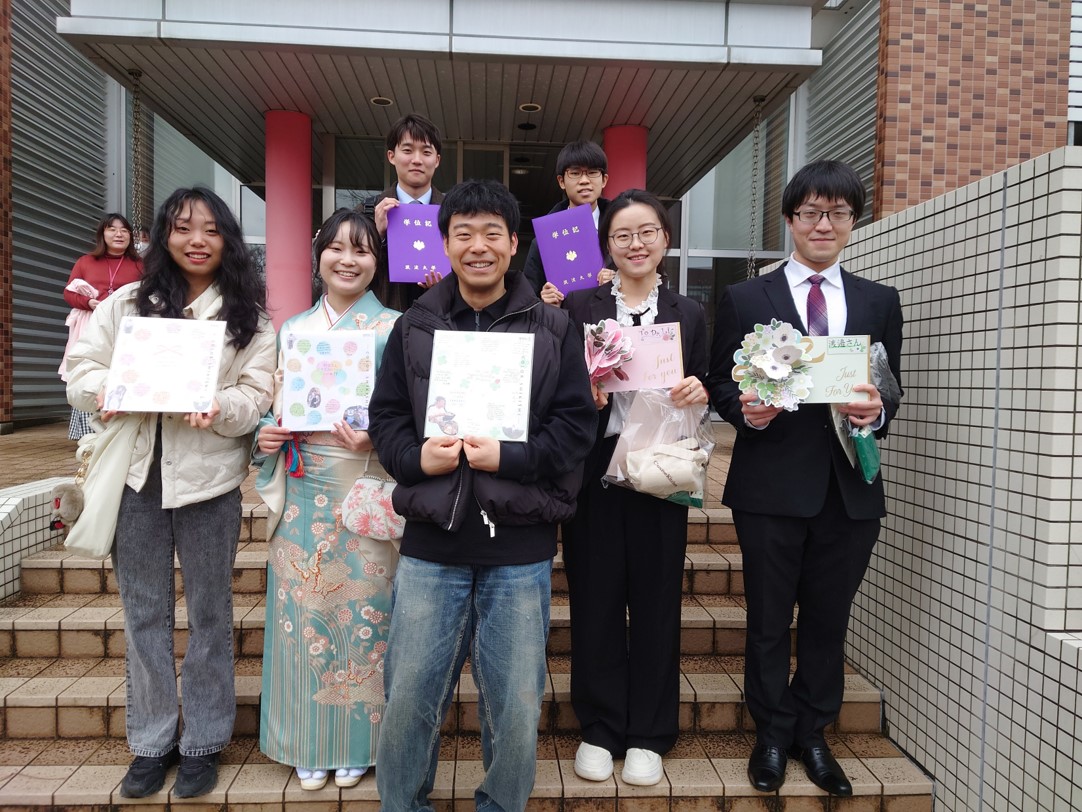
Li-san got Esaki-award!
Congratulations!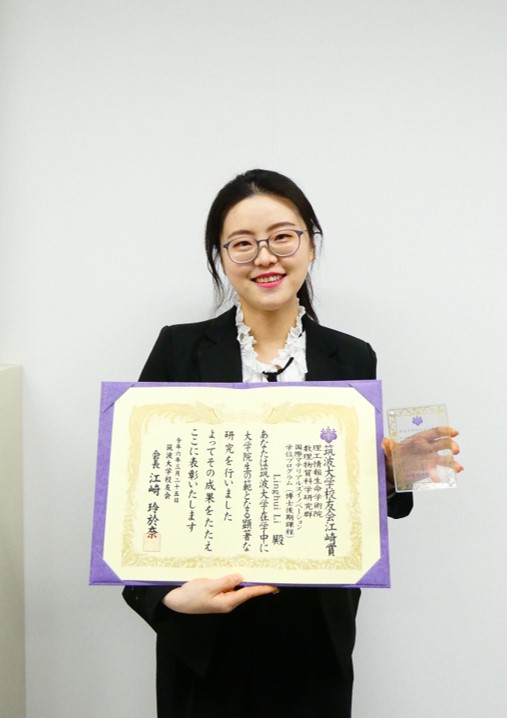
Watanabe-san got a Graduate school of Science and Technology Director's Award!
Congratulations!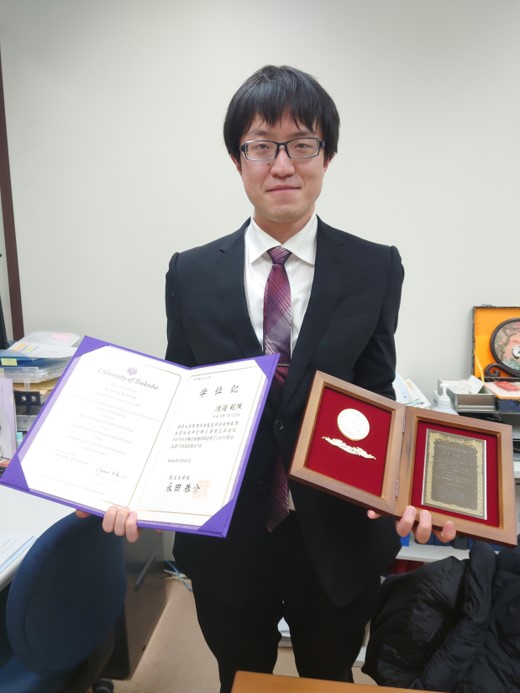
Noguchi-san got a Best Thesis Award (left) and a scholarship (right)!
Congratulations!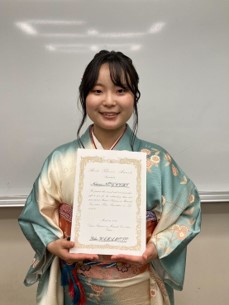
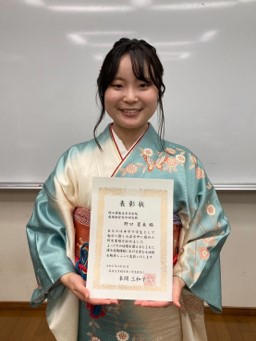
Takeshita-san and Takeyama-san got an Outstanding performance award, respectively!
Congratulations!
- 2024/2/9
- With Prof. Miyauchi group (Tokyo Tech.) and Dr. Hamada group (Osaka Univ.), our manuscript has been published in Small.
【Press release】
Towards A Better Way of Releasing Hydrogen Stored in Hydrogen Boride Sheets
Tokyo Tech. Univ. Tsukuba Osaka Univ.【Paper】
Electrolytic Hydrogen Release from Hydrogen Boride Sheets, Satoshi Kawamura, Akira Yamaguchi*, Keisuke Miyazaki, Shin-ichi Ito, Norinobu Watanabe, Ikutaro Hamada, Takahiro Kondo*, Masahiro Miyauchi*
Small (2024) 2310239.
【News】
The National Tribune (9th Feb), PhysORG (9th Feb), Medriva (9th Feb), EurekAlert (9th Feb), Innovation Newsnetwork (9th Feb), MIRAGE (9th Feb), Science Daily (9th Feb), Newssalt (13th Feb.), Mynavi news (13th Feb.),
- 2023/12/16
- At MRM2023/IUMRS-ICA2023 held in Kyoto International Conference Center
Ito-san, Hikichi-san, Yuan-san, Watanabe-san, Kang-san, Yasuda-san, and Fukuda-san presented their works in poster-session and
Li-san and Noguchi-san presented their works at oral session.
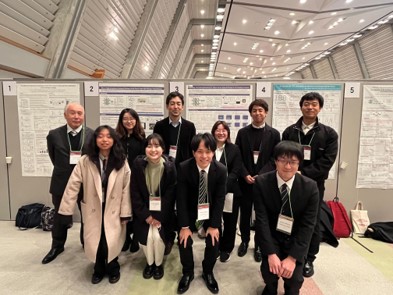
- 2023/12/8
- Noguchi-san (M2) got a award for her presentation in JVSS 2023.
(Annual Meeting of the Japan Society of Vacuum and Surface Science 2023)
Natsumi Noguchi (Univ. of Tsukuba)「Reduction of hydrogen release temperature by loading MgH2 on Ni/HB nanocomposites」
Natsumi Noguchi, Kazuho Goto, Shin-ichi Ito, Takeshi Fujita, Hideo Hosono, Shin-ichi Orimo, Takahiro Kondo
2023年日本表面真空学会学術講演会 講演奨励賞 受賞者決定のお知らせ
Congratulations!
- 2023/11/23
- Li-san, Noguchi-san, and Prof. Kondo visited to Institut Teknologi Bandung, ITB
and participated in SACSEM 9th (The 9th Southest Asia Collaborative Symposium on Energy Materials).
Li-san and Noguchi-san gave oral presentations and Prof. Kondo gave an invited talk.
Development of a highly stable nickel-foam-based boron monosulfide–graphene electrocatalyst for the oxygen evolution reaction
Linghui Li, Satoshi Hagiwara, Cheng Jiang, Haruki Kusaka, Norinobu Watanabe, Takeshi Fujita, Fumiaki Kuroda, Akiyasu Yamamoto, Masashi Miyakawa, Takashi Taniguchi, Hideo Hosono, Minoru Otani, Takahiro Kondo
Li-san received "Student Best Presentation Award"!Congratulations!
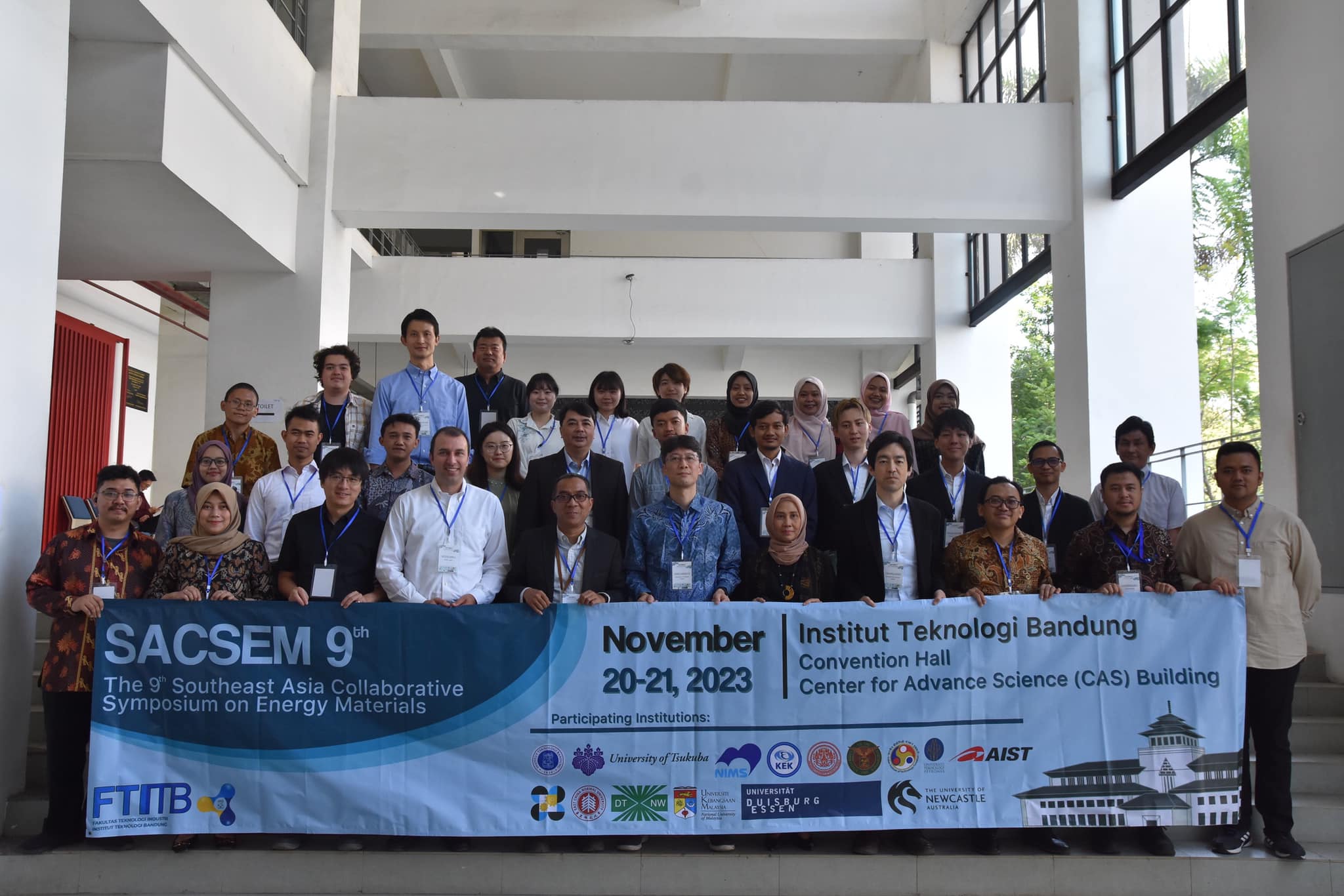
- 2023/11/7
- Prof Kondo visited to Consejo Superior de Investigaciones Científicas (CSIC)
INSTITUTO DE QUIMICA FISICA BLAS CABRERA and gave an invited talk.
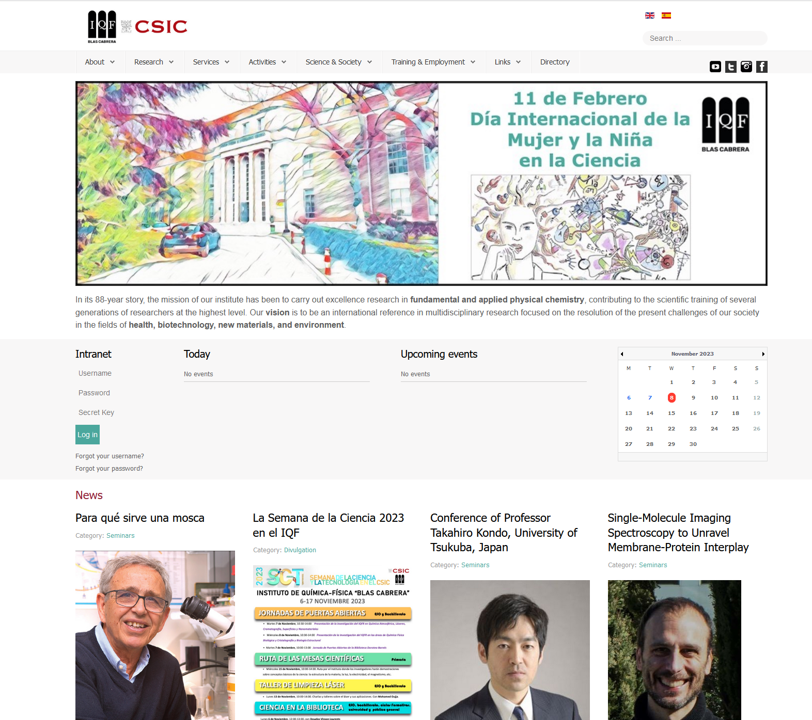
- 2023/11/3
- Li-san, Kang-san, and Watanabe-san Presented in oral session and Yuan-san, Noguchi-san, Yasuda-san, Fukuda-san presented in poster session at
JVSS2023 (Annual Meeting of the Japan Society of Vacuum and Surface Science 2023)
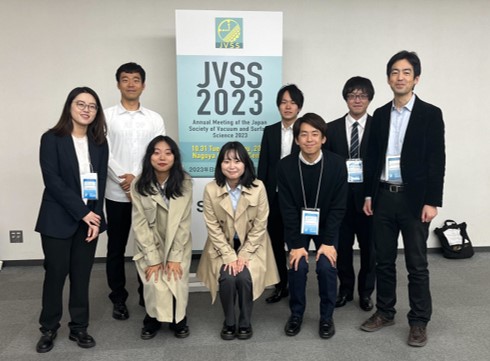
- 2023/10/1
- Two new students joined our lab.
- 2023/9/25
- Yuan-san completed master's degree and graduated.
Congratulations!!
- 2023/9/24
- Ito-san, Yuan-san, Watanabe-san, Noguchi-san, Kang-san, Yasuda-san, and Fukuda-san presented their research results in
The 84th JSAP Autumn Meeting 2023 (Kumamoto-jo Hall)
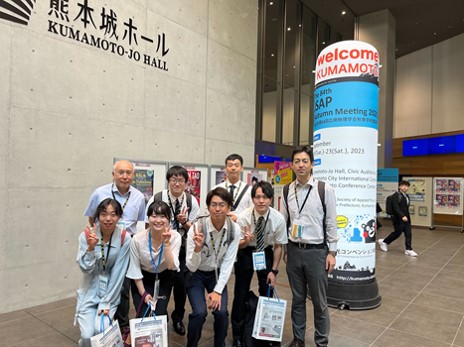
- 2023/9/4
- Research results by Hikichi-san et al. has been published inAdvanced Materials Interfaces!
Controlling Photoinduced H2 Release from Freestanding Borophane Sheets under UV Irradiation by Tuning B–H bonds
Miwa Hikichi, Junpei Takeshita, Natsumi Noguchi, Shin-ichi Ito, Yukihiro Yasuda, Luong Thi Ta, Kurt Irvin M. Rojas, Iwao Matsuda, Satoshi Tominaka, Yoshitada Morikawa, Ikutaro Hamada, Masahiro Miyauchi,* and Takahiro Kondo*
Advanced Materials Interfaces 10 (2023) 2300414.
It is selected as a Front cover picture!
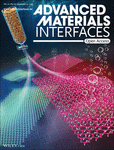
- 2023/8/9
- Prof. Kondo gave an invited talk at "The 2023JACKS Hydrogen Forum"
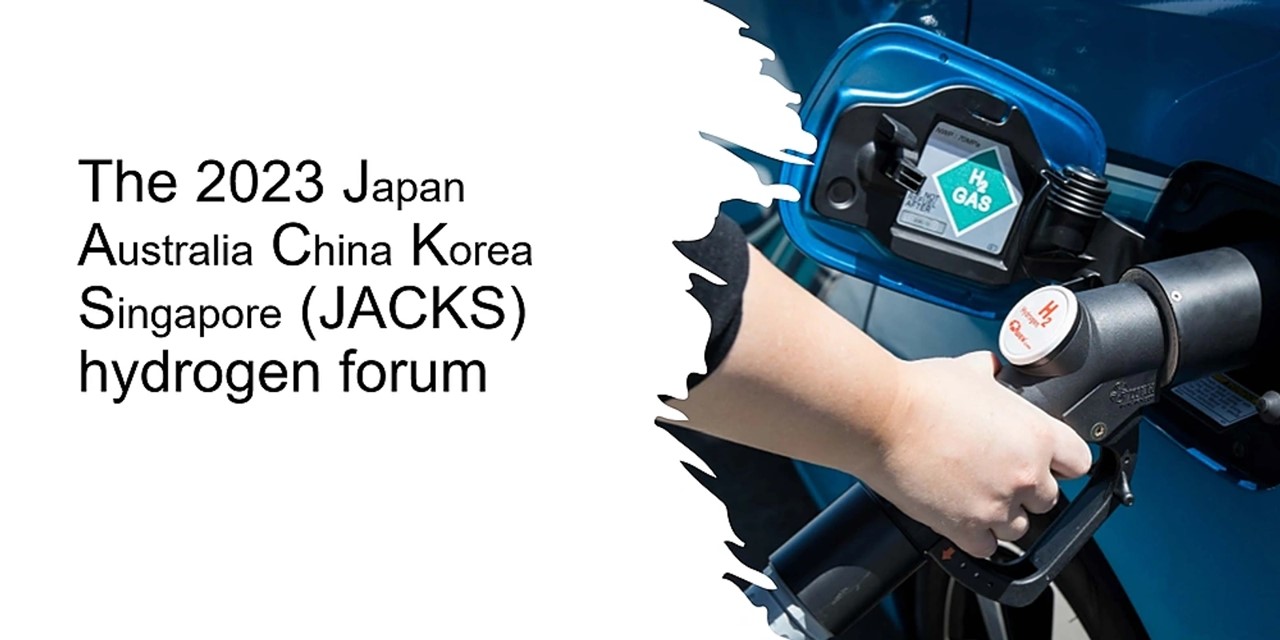
- 2023/8/2
- Yuan-san (M2) and Prof. Kondo attended at "2023 China-Japan International Symposium on Photonic Materials" and gave a poster presentation and an invited talk, respectively.

- 2023/7/27
- Kondo-lab and Takeyasu-lab conducted joint camp-meeting of "2023 Catalyst and Surface Science group summer workshop".
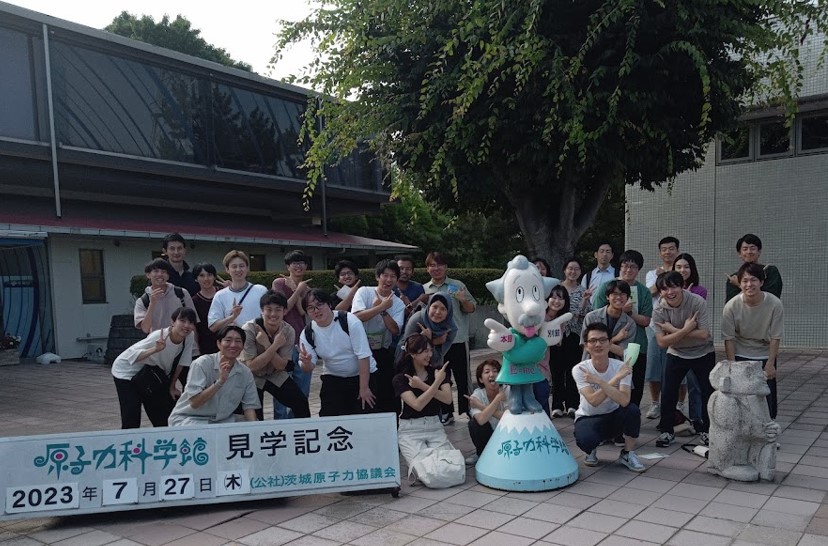
- 2023/7/11
- Research results by Li-san (D3 student) et al. has been published in Chem. Eng. J.
【Press release】
https://www.tsukuba.ac.jp/en/research-news/20230711140000.html
Univ. Tsukuba TUAT Kochi Univ. Tech.【Paper】
Boron monosulfide as an electrocatalyst for the oxygen evolution reaction
Linghui Li, Satoshi Hagiwara, Cheng Jiang, Haruki Kusaka, Norinobu Watanabe, Takeshi Fujita, Fumiaki Kuroda, Akiyasu Yamamoto, Masashi Miyakawa, Takashi Taniguchi, Hideo Hosono, Minoru Otani, Takahiro Kondo*
Chemical Engineering Journal 471 (2023) 144489.
- 2023/7/2
- Professor Kondo gave invited talk atGordon Research Conference!
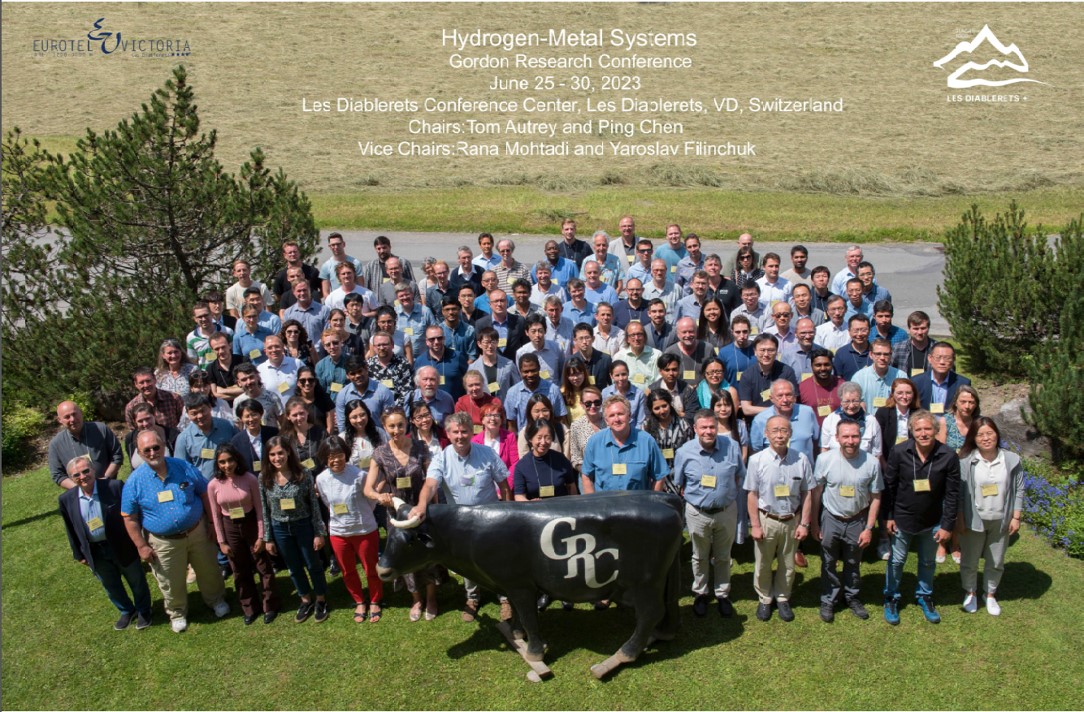
- 2023/5/24
- Research results by Ito-san et al. has been published in Physical Chemistry Chemical Physics!
Effective treatment of hydrogen boride sheets for long‐term stabilization
Shin‐ichi Ito, Miwa Hikichi, Natsumi Noguchi, Mei Yuan, Zihao Kang, Kosei Fukuda, Masahiro Miyauchi, Iwao Matsuda, Takahiro Kondo*
Phys. Chem. Chem. Phys. 25 (2023) 15531-15538.
- 2023/5/24
- Li-san (D3 student) and Yoshioka-san (graduated at this March) got awards
Congratulations!
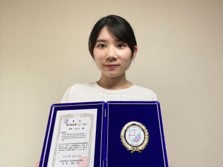
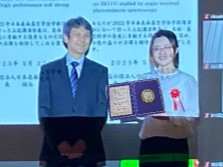
- 2023/4/6
- Three new students joined our lab.
2022
- 2023/3/24
- Goto-san and Yoshioka-san completed master's degree and graduated.
Yasuda-san and Fukuda-san completed bachelor's degree and graduated.
Congratulation!!
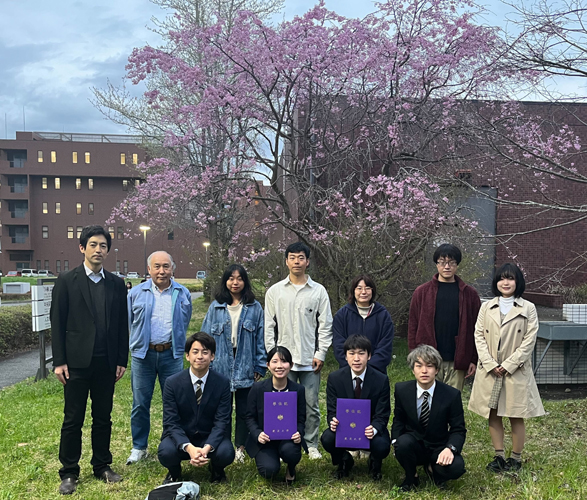
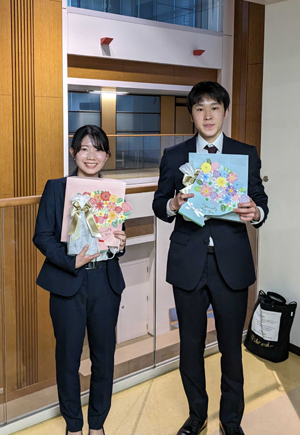
- 2023/3/24
- Yoshioka-san got a prize for his masters thesis defense presentation.
Congratulation!!
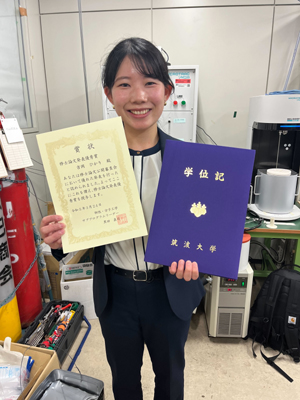
- 2023/2/16
- The paper by Watanabe-san (M1 student) and co-workers has been published in Molecules
Rhombohedral Boron Monosulfide as a p-Type Semiconductor
Norinobu Watanabe, Keisuke Miyazaki, Masayuki Toyoda, Kotaro Takeyasu, Naohito Tsujii, Haruki Kusaka, Akiyasu Yamamoto, Susumu Saito, Masashi Miyakawa, Takashi Taniguchi, Takashi Aizawa, Takao Mori, Masahiro Miyauchi*, Takahiro Kondo*
Molecules 28 (2023) 1896. (9 pages).
- 2023/02/13
- Professor Kondo received Academic award from the Society of Boron, Borides and Related Materials of Japan on 2023/2/11. We would like to express our deepest gratitude to all the students and staff in our laboratory, related professors, collaborators, and all those who have supported us.
- 2023/1/26
- Li-san and Yoshioka-san got award of "Student award of Japan society of vacuum and surface science 2022"!
Information at JVSS site (written in Japanese language)
Congratulations !
- 2022/12/27
- Prof. Kondo received congratulations from the laboratory members for his appointment as a professor.
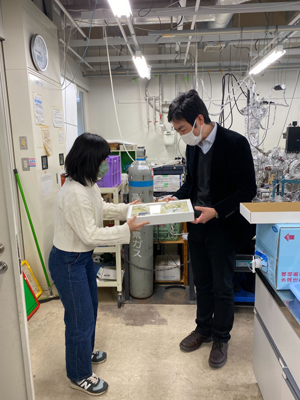
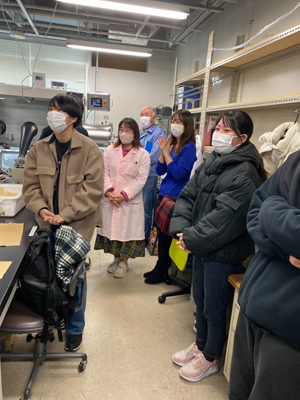
- 2022/11/26
- The paper by Noguchi-san (M1 student) and co-workers has been published in Molecules
Highly dispersed Ni nanoclusters spontaneously formed on hydrogen boride sheets
Natsumi Noguchi, Shin-ichi Ito, Miwa Hikichi, Yohei Cho, Kazuho Goto, Atsushi Kubo, Iwao Matsuda, Takeshi Fujita, Masahiro Miyauchi*, Takahiro Kondo*
Molecules 27 (2022) 8261. (12 pages).
- 2022/11/18
- BBQ
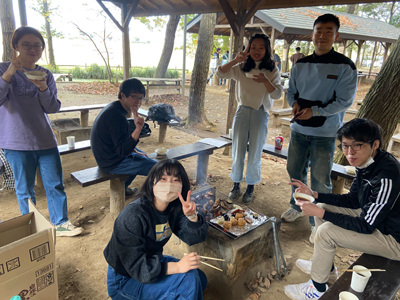
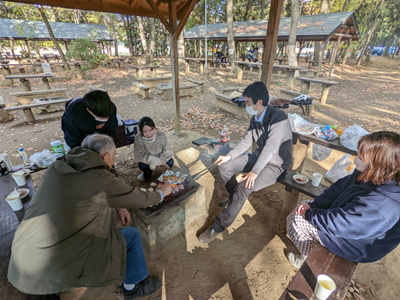
- 2022/10/27
- The research article based on the results of the graduated student (Master course) Taiga Goto has been published:
Carbon dioxide adsorption and conversion to methane and ethane on hydrogen boride sheets
Taiga Goto, Shin-ichi Ito, Satish Laxman Shinde, Ryota Ishibiki, Yasuyuki Hikita, Iwao Matsuda, Ikutaro Hamada*, Hideo Hosono, Takahiro Kondo*
Communications Chemistry 5 (2022) 118 (10 pages).
This paper was selected of the Collection of Communications Chemistry:Energy storage and conversion
Congratulations !
- 2022/09/15
- At THE 22ND INTERNATIONAL VACUUM CONGRESS IVC-22,
Li-san, and Yoshioka-san gave oral presentations.
Goto-san, Noguchi-san, and Watanabe-san gave poster presentation.
Li-san, and Yoshioka-sa got IUVSTA-Elsevier Student award!
Congratulations !!!!
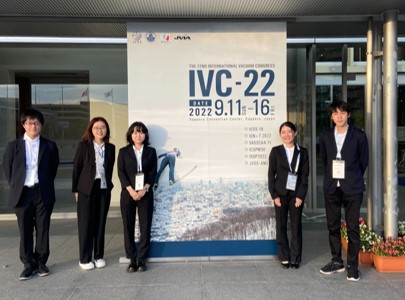
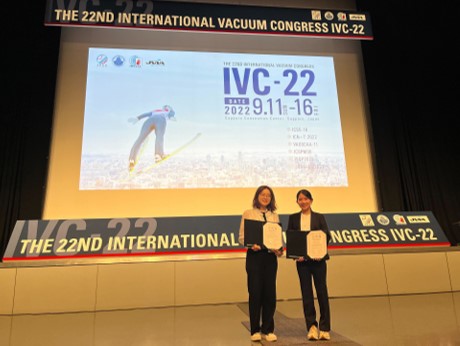
- 2022/09/10
- At ISBB2022, the 21st International Symposium on Boron, Borides and related materials,
Associate Professor Kondo gave invited talk. Li-san, Goto-san, Yoshioka-san, and Noguchi-san, gave oral presentations.
Watanabe-san gave poster presentation.
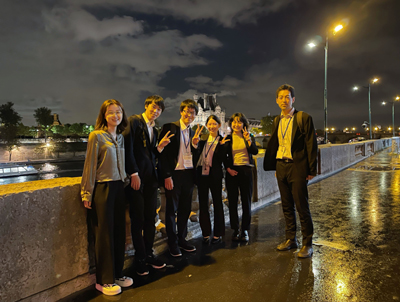
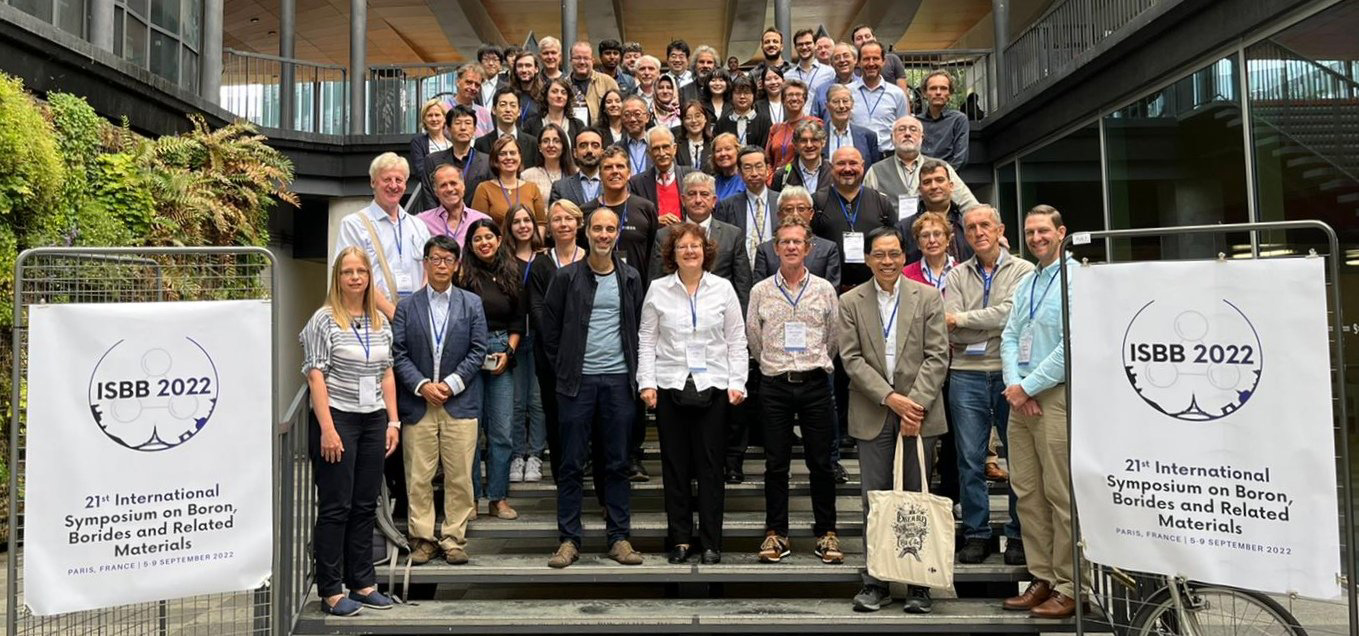

- 2022/05/21
- Associate Professor Kondo received the title of 2022 Fellow of the Surface and Vacuum Society of Japan from the Surface and Vacuum Society of Japan at the award ceremony held after the Ordinary General Meeting of the Society on Saturday, May 21, 2022. We would like to express our deepest gratitude to all the students and staff in our laboratory, related professors, collaborators, and all those who have supported us.
- 2022/05/16
- Dr. Shinde moved to Indian Institute of Technology Hyderabad as an Assistant Professor!
- 2022/04/26
- Dr. Kondo introduced about our research in front of U.S. Ambassador Extraordinary and Plenipotentiary Rahm Israel Emanuel and his delegation.University of Tsukuba News
- 2022/04/06
- New students joined as lab members!
- 2022/4/01
- Dr. Kondo is assinged as director of new R&D center“R&D Center for Zero CO2 Emission with Functional Materials” of University of Tsukuba
2021
- 01/04/2022
- Dr. Kondo is assinged as director of new R&D center "R&D Center for Zero CO2 Emission with Functional Materials" of University of Tsukuba.Nikkei (Newspaper)
- 31/03/2022
- Our laboratory introduction movie is now open in Youtube.
- 25/03/2022
- Kawamura-kun and Kusaka-kun completed master's degree and graduated.
Noguchi-san and Watanabe-kun completed bachelor's degree and graduated.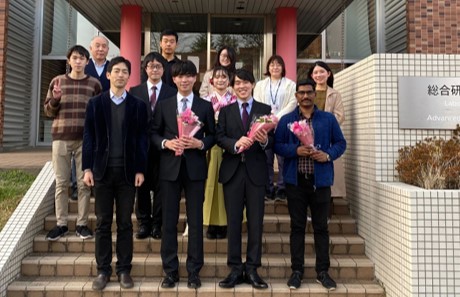
- 12/02/2022
- It is announced thath Associate Professor Kondo will be received the title of 2022 Fellow of the Surface and Vacuum Society of Japan from the Surface and Vacuum Society of Japan at the award ceremony held after the Ordinary General Meeting of the Society on Saturday, May 21, 2022. We would like to express our deepest gratitude to all the students and staff in our laboratory, related professors, collaborators, and all those who have supported us.
- 17/12/2021
- In the international conference of Materials Research Meeting 2021(MRM2021), Kawamura-kun, Kusaka-kun, Goto-kun, and Yoshioka-san conducted poster presentation
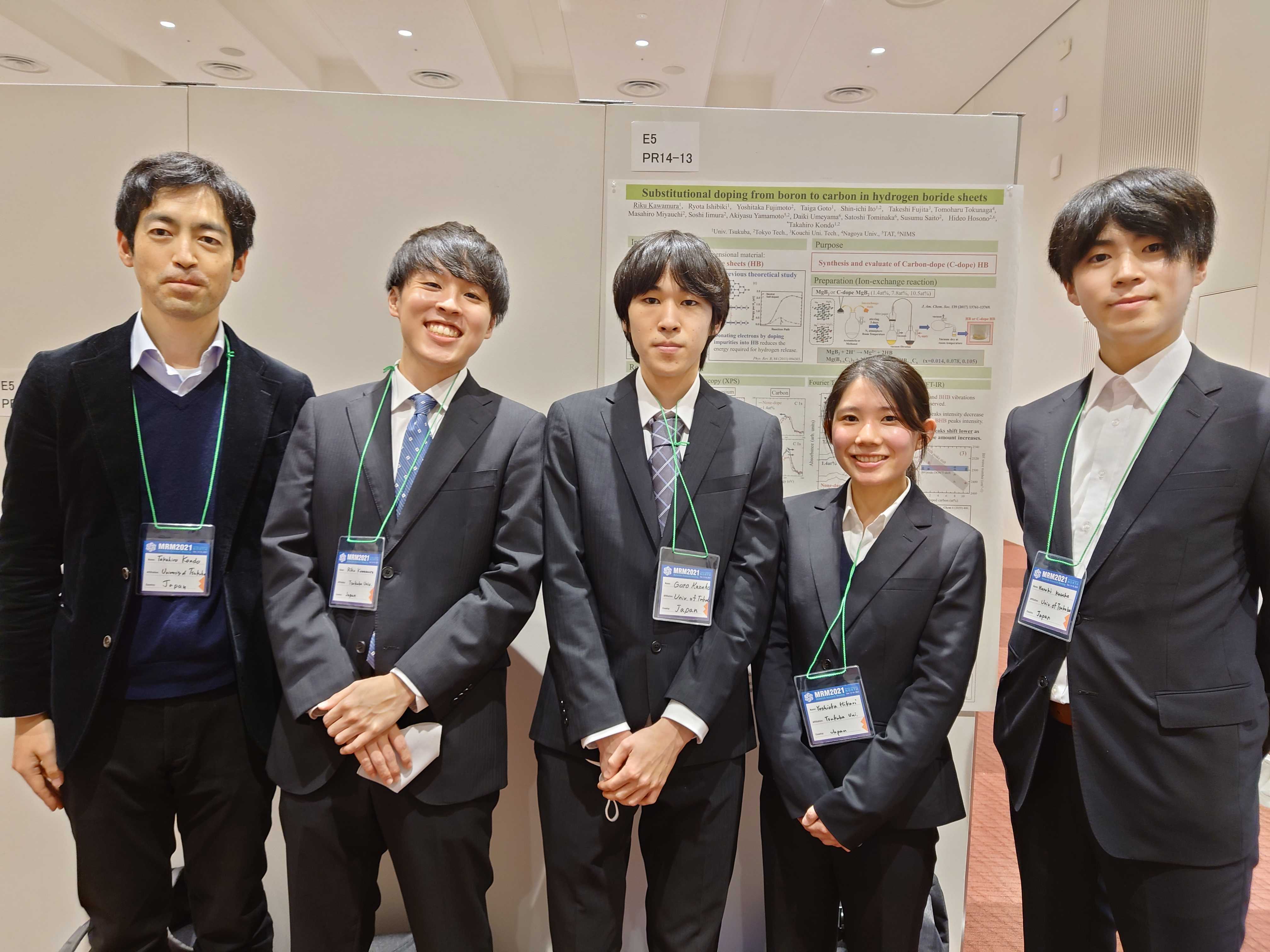
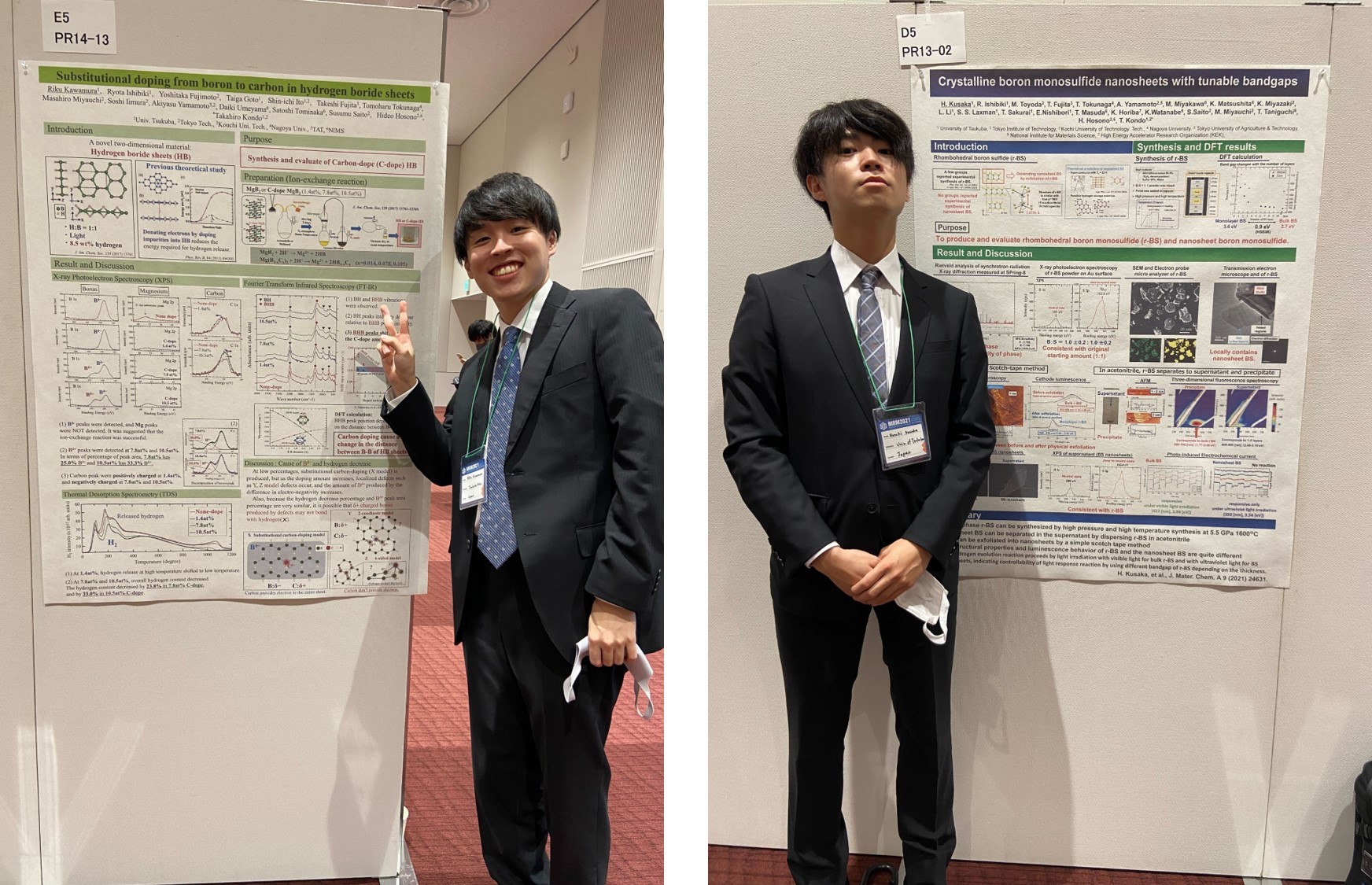
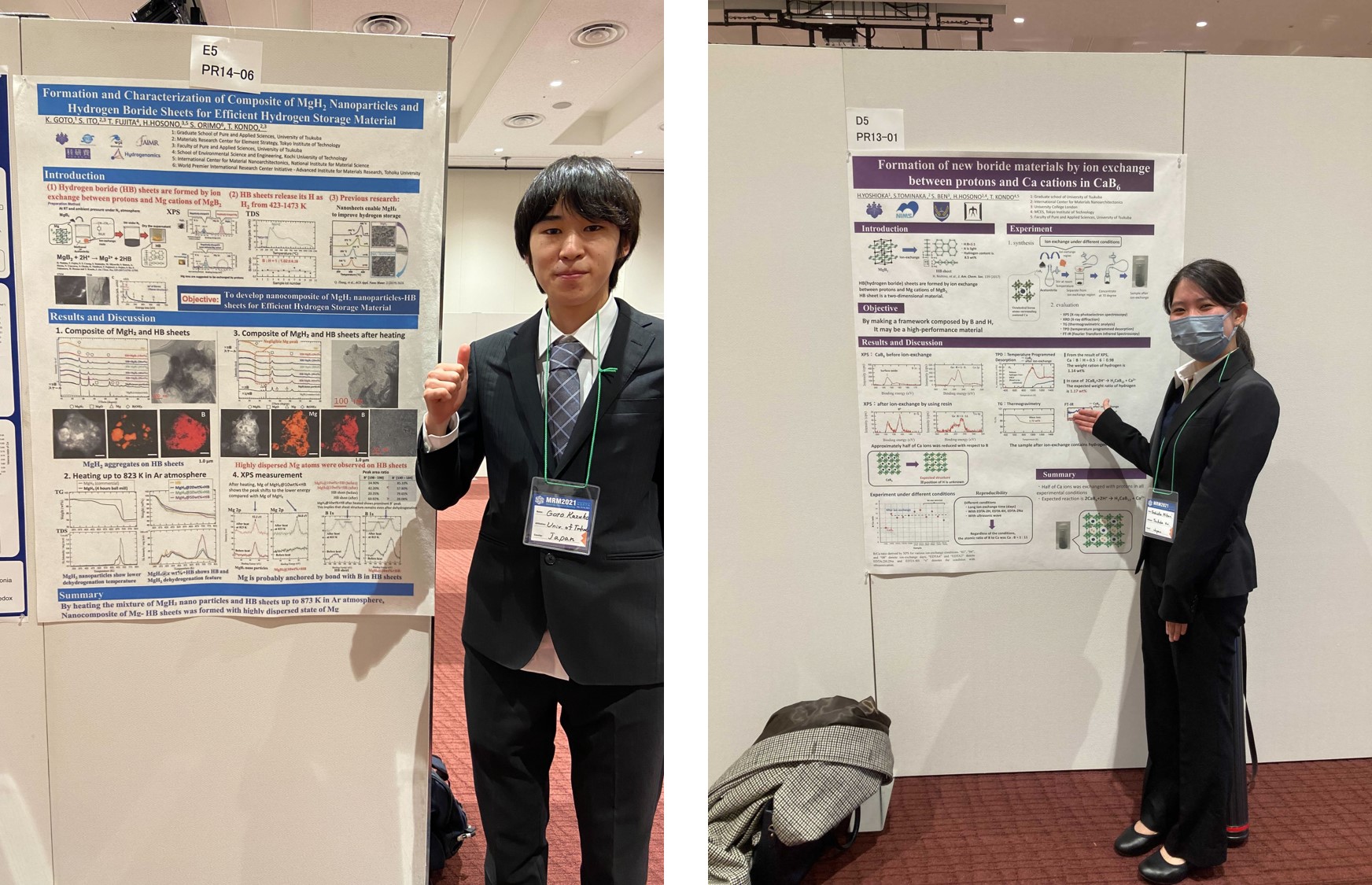
- 01/12/2021
- In the international conference of The 9th International Symposium on Surface Science (ISSS-9) Kawamura-kun and Kusaka-kun conducted oral presentation and Goto-kun and Yoshioka-san conducted poster presentation.
- 28/10/2021
- The paper about "Boron monosulfide nanosheets" has been published.
● J. Mater. Chem. A 9 (2021) 24631-24640
[ Press release ]
Univ. Tsukuba (English), Univ. Tsukuba (Japanese), Tokyo Tech., Kochi University of Technology, TAT, Nagoya Univ., KEK
[ News papers ]
EurekAlert AAAS(10/28), Nikkei(10/28), IT media NEWS(10/28), Science Times(11/1), PhysORG(10/28), nano werk(10/28), ScienceDaily(10/28), MIRATAGE(10/28), Yahoo News(10/28), Excite News(10/28), SPring8(10/28), Tsukuba Science News(10/28), Newspaper of science(11/19), AZO NANO(10/29), OPTRONICS ONLINE(10/28), 客観日本(2022/1/20)
- 02/04/2021
- New students joined as lab members!
2020
- 25/03/2021
- Congratulation of the graduation!!
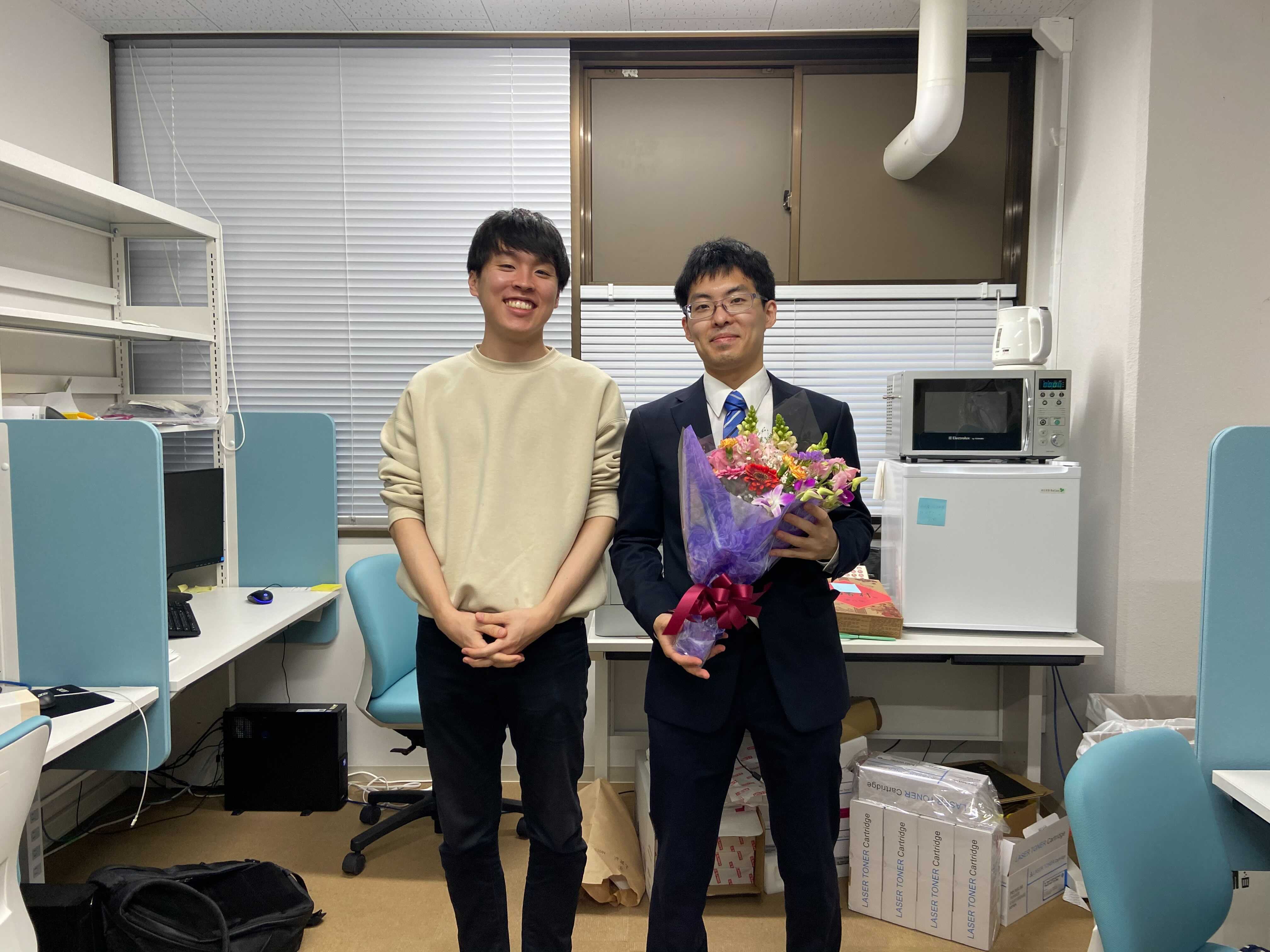
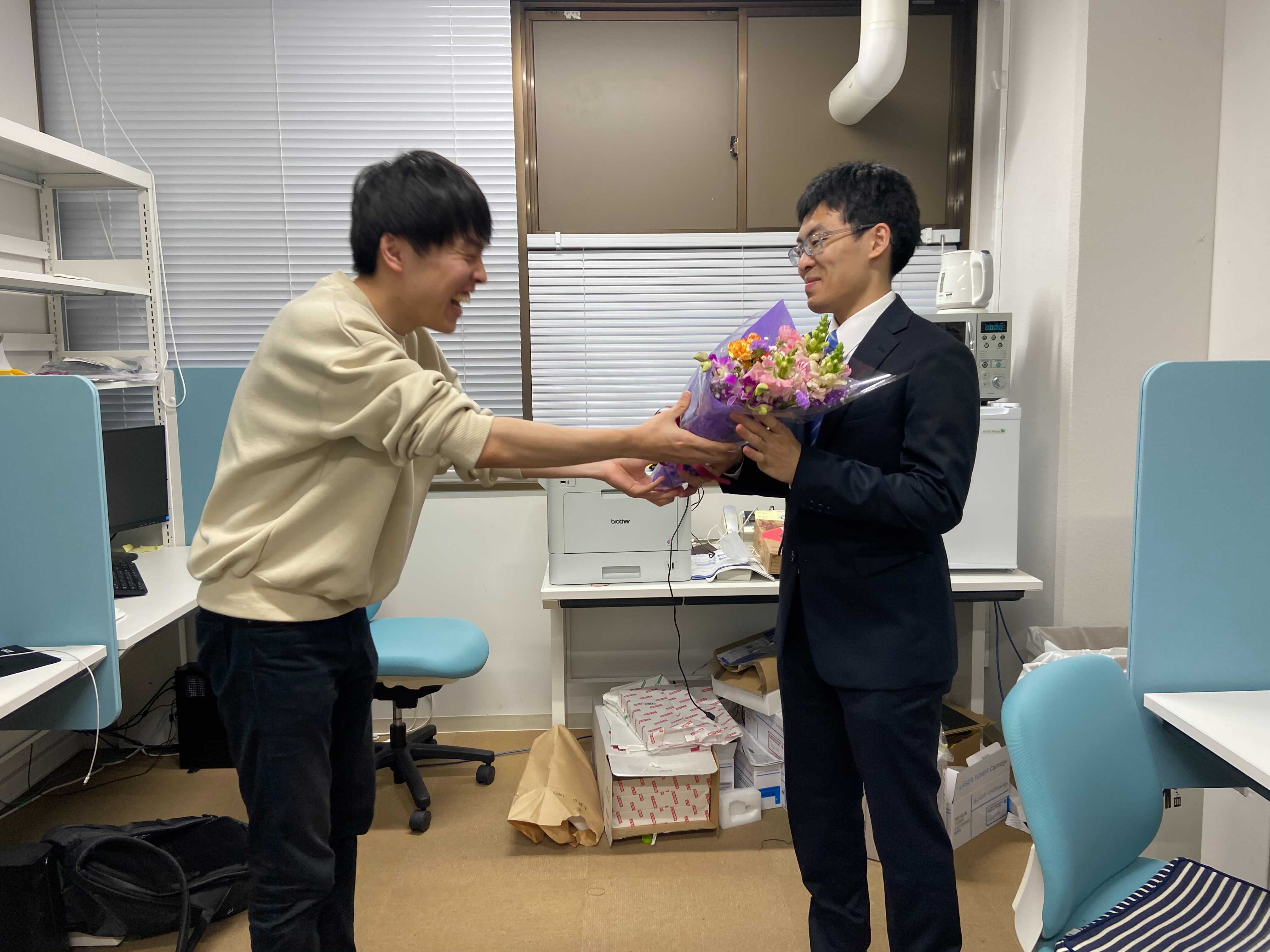
- 04/03/2021
- Mr. Hikita got a prize for his masters thesis defense presentation.
Congratulation!!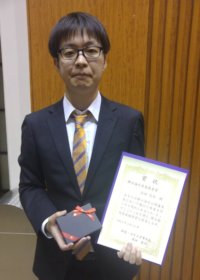
- 01/02/2021
- Prof. Kondo was selected as 2020BEST FACULTY MEMBERDetail
- 01/10/2020
- Dr. Shinde becomes our lab member as Postdoctoral researcher.
- 01/07/2020
- Our new paper has been selected as an Editor's Choice in Chemistry Letters.
● Chem. Lett. 49 (2020) 789-793.
( What is "Editor's Choice" : http://editorialoffice.csj.jp/cl/ECexp.pdf )Selected as an inside cover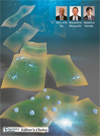
- 13/05/2020
- Our hydrogen boride sheets were picked up as the topic of this month of Nature INDEX for Univ. Tsukuba. The focus was on article published in Nature Communications in 2019 in collaboration with Prof. Miyauchi's group at Tokyo Tech. and other groups.
Univ. Tsukuba HP, Nature index :"Nanosheets show promise for storing hydrogen"
- 03/04/2020
- New students joined as lab members!
2019
- 25/03/2020
- Mr. Ishibiki got a prize for his masters thesis defense presentation.
Congratulation!!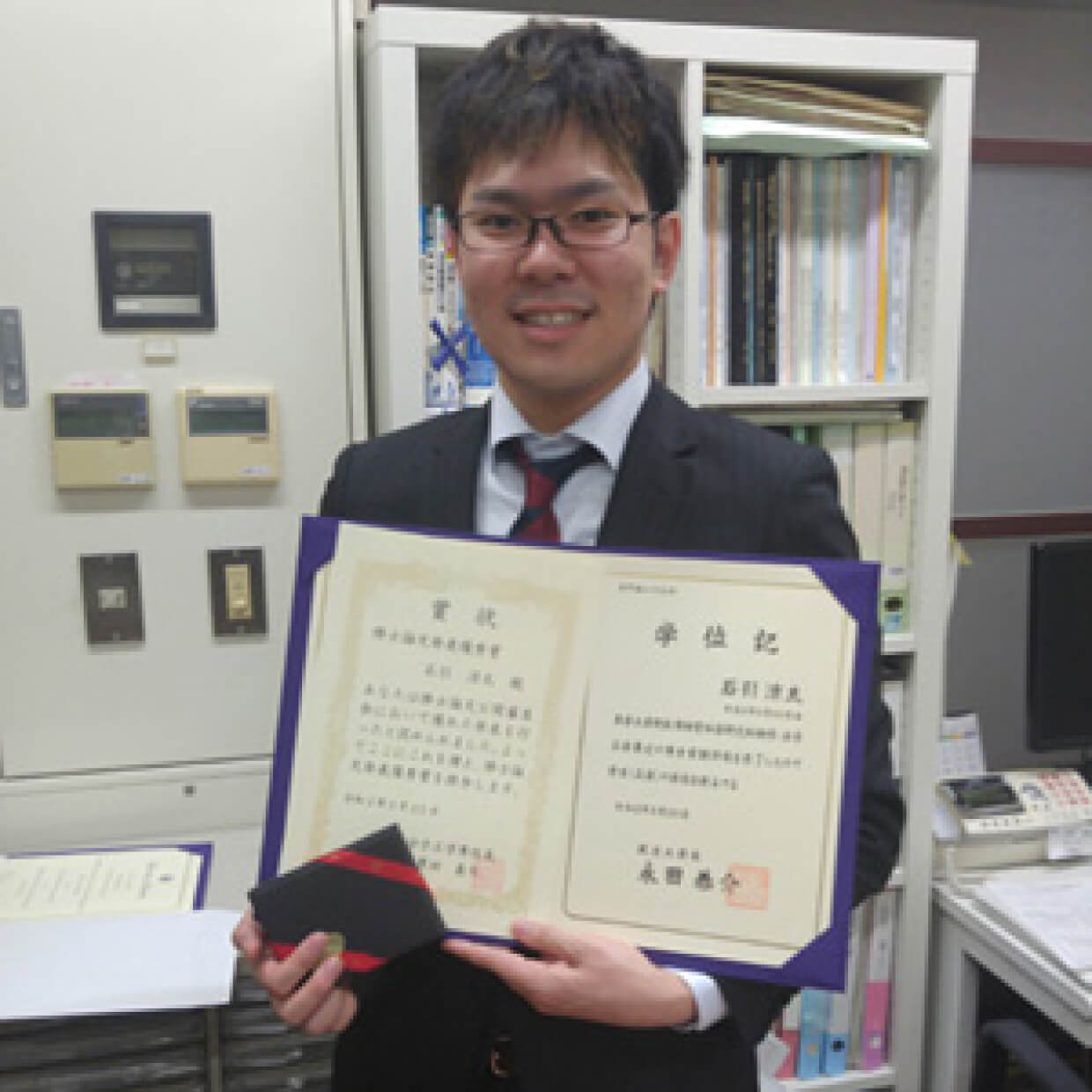
- 09/01/2020
- Prof. Kondo got a Best Poster Award 2020 in "1st International Symposium Hydrogenomics / 14th International Symposium Hydrogen & Energy".
- 29/12/2019
- Mr. Hikita got a student prize for his poster presentation in "Surface Interface Spectroscopy 2019".
Congratulation!!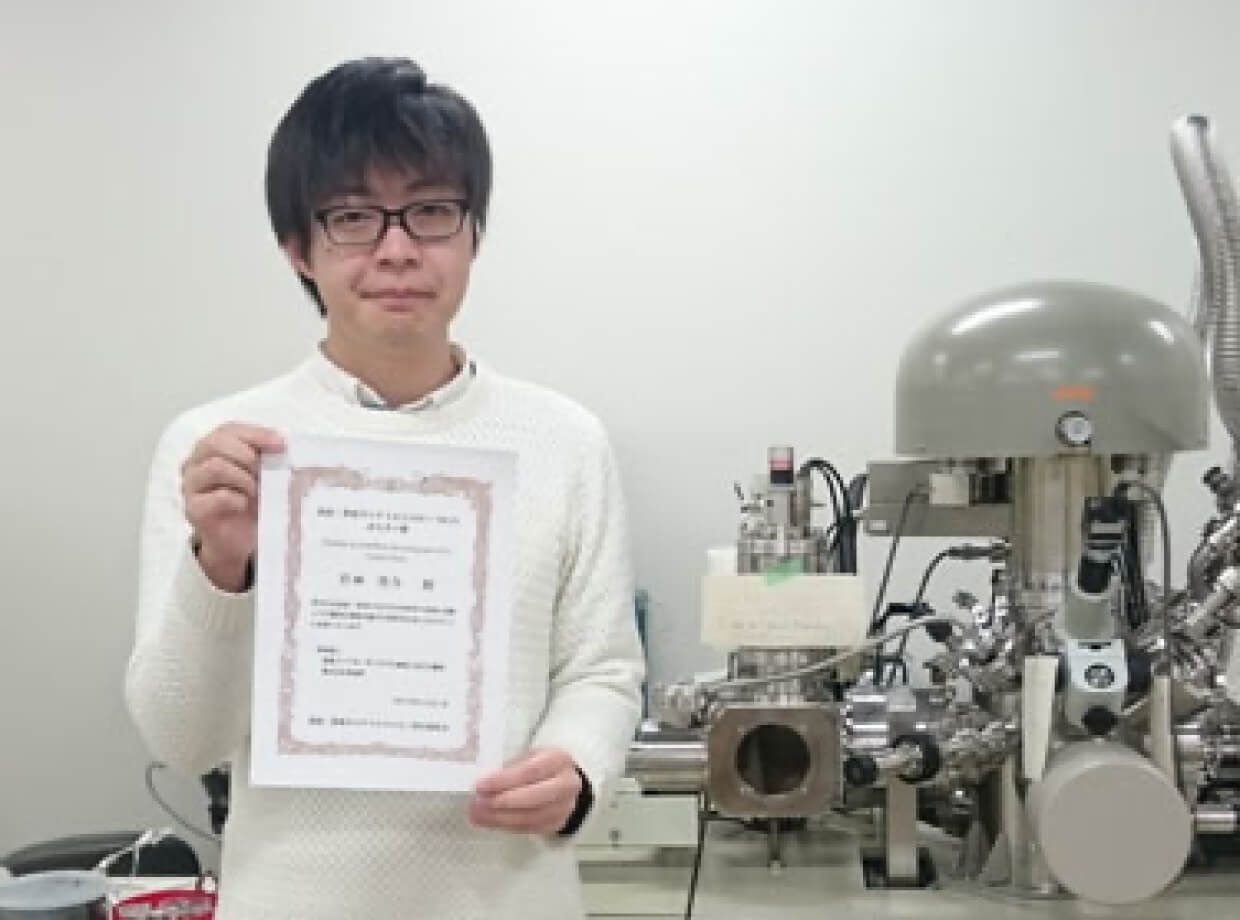
- 10/12/2019
- Our new paper has been published in Chem : Chem 6 (2020) 406-418.
[ Press release ]
Univ. Tsukuba, NIMS, Tokyo. Tech., JASRI, SPring8, ISSP, Univ. Tokyo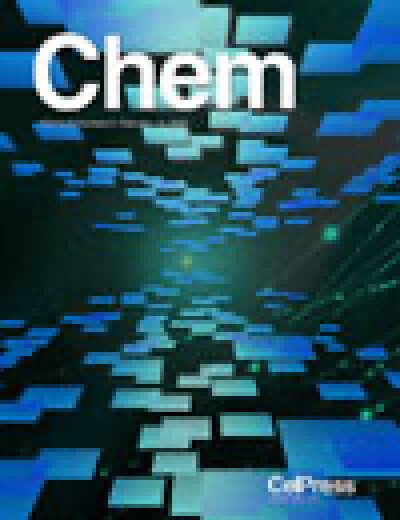
- 25/10/2019
- Our new paper has been published in Nature Communications :
Nature Communications 10 (2019) 4880.
[ Press release ]
Univ. Tsukuba, Tokyo. Tech., ISSP, Univ. Tokyo, Kochi University of Technology
- 22/27/09/2019
- Prof. Kondo, Mr. Ishibiki, and Mr. Goto have attended to the international conference of 20th International Symposium on Boron, Borides and Related Materials (ISBB 2019).
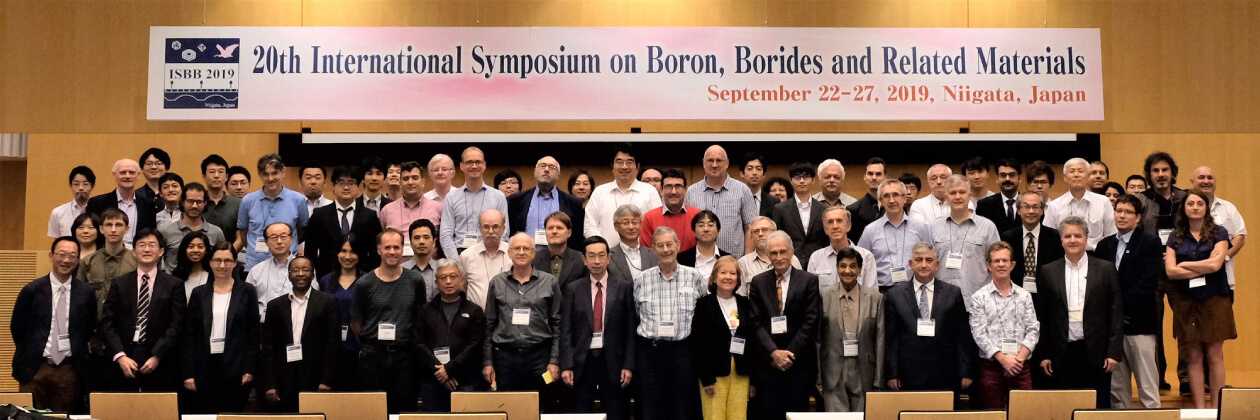
- 25/06/2019
- Our new paper has been published in Nature Chemistry : Nature Chemistry 11 (2019) 722-729.
[ Press release ]
Univ. Tsukuba, Univ. Osaka
- 24-27/06/2019
- Prof. Kondo and Mr. Ishibiki have attended to the international conference of Euroboron8 which was held at Montpellier in France.
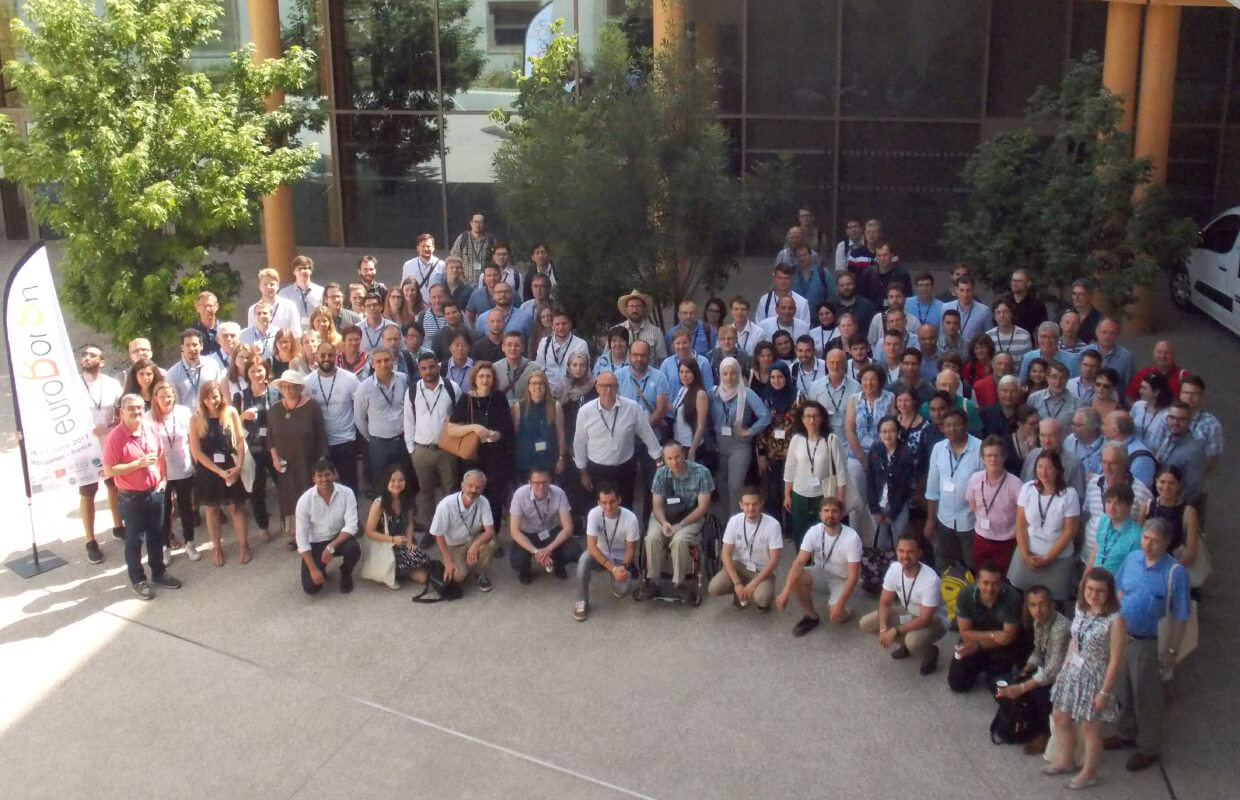
- 10-11/06/2019
- 近藤准教授が分子科学研究所で開かれた4th Solid Chemistry Forum
,
- 10/04/2019
- New research projects are started. One of them is Hydrogenomics.
(Grant-in-Aid for Scientific Research on Innovative Areas, MEXT, Japan) また、文部科学省 科学研究費助成事業 基盤研究B(研究代表者)にも採択されました。
また、文部科学省 科学研究費助成事業 基盤研究B(研究代表者)にも採択されました。
- 04/04/2019
- New students joined as lab members!
2018
- 30/11/2018
- Laura-san from Prof. Niels Benson-lab at University of Duisburg-Essen have stayed our lab to conduct experiment with our STM (old USM1300) for one month (and got nice results!).
- 12/07/2018
- Prof. Kondo and Mr. Ishibiki visited to Prof. Ivan laboratory in University College London (UCL) to measure the solid state Nuclear Magnetic Resonance and Raman spectroscopy for our hydrogen boride sheets as a function of temperature as collaboration research by JSPS Core-to-Core Program A Advanced Research Networks for Materials Research Center for Element Strategy, Tokyo Institute of Technology.
The following picture shows Dr. Raul, Mr. Ishibiki, and Kurara-san.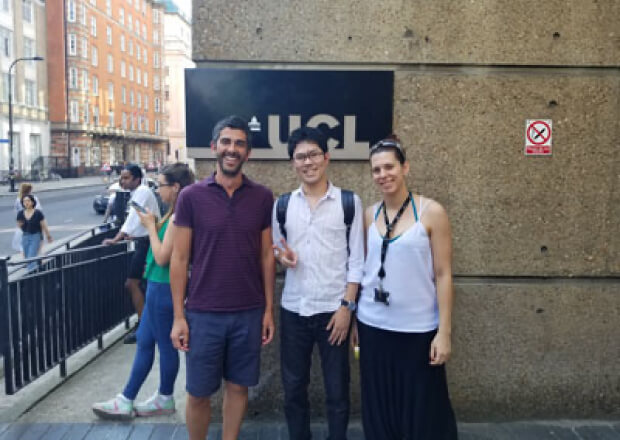
- 25/06/2018
- Our paper about HB sheets in JACS was introduced in Chem as an example of incredibly creative synthesis storategy and discovery.
- 27/04/2018
- We start a new home page of our laboratory.
- 01/04/2018
- KONDO Laboratory is starting!
- 10/01/2018
- Our research has been introduced in HP of Univ. Tsukuba
#085:平面に広がる新しい材料の世界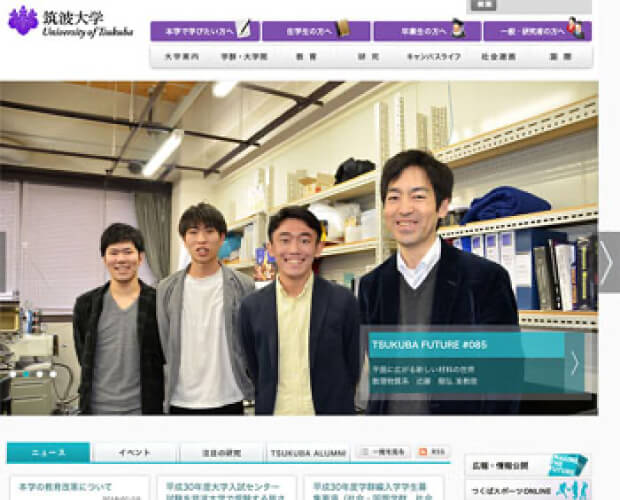
- 16/11/2017
- Sakura Science Exchange Program. (JST HP)
Seminar
Invited talkMaterials Science Seminar
| Date | 4th Nov. 2022 (PM 14:00-) |
|---|---|
| Location | 総合研究棟B112+Zoom online |
| Title | 筑波大学第三学群基礎工学類から米国での研究生活へ |
| 講演者 | 荻津格 (米国ローレンスリバモア国立研究所) |
- Abstract
Invited talkMaterials Science Seminar
| Date | 17th Dec. 2019 (PM 15:15-16:15) |
|---|---|
| Location | 3B213 |
| Title | Geo‐inspirationto extend the library of functional inorganic nanoparticles |
| Speaker | Dr. David Portehault (Laboratoire de Chimie de la Matiere Condensee de Paris (LCMCP), Researcher of CNRS) |
- Abstract
Invited talkMaterials Science Seminar
| Date | 16th Jan. 2019 (AM 10:30-11:30) |
|---|---|
| Location | 3B213 |
| Title | Physical Chemistry with Single Molecules- Hydrogen-Transfer Dynamics Studied by Scanning Probe Microscopy |
| Speaker | Dr. Takashi Kumagai (Group leader, Department of Physical Chemistry, Fritz-Haber Institute) |
- Abstract
- H-atom transfer and H-bond rearrangement are involved in many important physical, chemical, and biological processes such as proton conductor, acid?base reactions, and DNA [1]. However, an accurate and quantitative description of H-atom/bonding dynamics remains a very challenging topic and nuclear quantum effects (NQEs) and anharmonicity of the potential energy surface are outstanding problems in the field. In order to examine such dynamics, it is necessary to investigate model systems at the single-molecule level because NQEs and anharmonic nature are quite susceptive to a local environment of individual molecules and hidden by inhomogeneities of bulk samples. Low-temperature SPM has provided a new opportunity to study hydrogen-atom/bonding dynamics [2]. Single-molecule tautomerization serves as a fascinating model and I will discuss hydrogen-transfer reactions occurring through various external stimuli as well as quantum tunneling [3].
- References
-
- Hydrogen-transfer reaction. J. T. Hynes, J. P. Klinman, H.-H. Limbach, R. L. Schowen, Weley-VCH, 2007.
- TK, Prog. Surf. Sci. 90, 239 (2015).
- TK et al. Phys. Rev. Lett. 111, 246101 (2013).; TK et al. Nature Chem. 6, 41 (2014).; J. Ladenthin et al. ACS Nano 9, 7287 (2015).; H. Bockmann et al. Nano Lett. 16, 1034 (2016).; J. Ladenthin et al. Nature Chem. 8, 935 (2016).; M. Koch et al. J. Am. Chem. Soc. 139, 12681 (2017).; TK, J. Chem. Phys. 148, 102330 (2018):; H. Bockmann et al. Nano Lett. 18, 152 (2018).
Seminar and invited talk up to 2017
Invited talkセミナー
| Date | 2016年11月24日(木) 14時30分開始予定(60分程度) |
|---|---|
| Location | 3B213プレゼンテーションルーム |
| Title | Eley-Rideal reactions of hot atoms and molecules at surfaces |
| Speaker | Professor Dr Aart W. Kleijn (Director, Center of Interface Dynamics for Sustainability, Institute of Materials, CAEP) |
- Abstract
- Most chemical reactions proceed along the Langmuir-Hinshelwood (LH) route: reactants adsorb at a surface and possibly dissociate, the adsorbates diffuse over the surface, find reaction partners, and form a product molecule that subsequently desorbs. Because making and breaking of bonds is more facile at surfaces than in the gas or liquid phase, heterogeneous catalysis is applied a lot in (bulk) chemistry. It decreases activation barriers and steers the reaction in the desired direction. The mechanism of incident radicals, for which no chemical bond needs to be broken, can proceed in a different way. Often these reactions are exothermic and can act promptly. That the mechanism is different was already recognized by Eley and Rideal (ER) around 1940. Such reactions are rare and recently have been studied extensively for hydrogen atoms. For non-hydrogenic, ‘heavy’ atoms they were considered unlikely. Recently at the FOM Institute DIFFER we have identified such reactions for hyperthermal nitrogen atoms reacting with adsorbed O or N atoms on Ag and Ru. The reaction cross sections are surprisingly large, an up to now not fully understood effect. The mechanism of such ER reactions will be discussed in this presentation. One way of turning (LH) reactions into ER reactions could be by specific excitation of the internal degrees of freedom of molecules. Vibrational excitation of CH4 leads to much larger dissociative sticking coefficients. We have started a project to increase the reactivity of CO2 by plasma activation. Both in the gas phase and for reactions at a catalyst distinct effects of the plasma activation can be observed. In this presentations first results of plasma catalysis of CO2 will be shown.
Invited talkセミナー
| Date | 2016年11月16日(水) 13時00分開始予定(60分程度) |
|---|---|
| Location | 3B213プレゼンテーションルーム |
| Title | 劈開できないシリコンから二次元シリコン物質を創る技術 |
| Speaker | (株)豊田中央研究所 中野秀之 主席研究員 |
- Abstract
- シリコンはダイヤモンド型構造をとるため劈開面が無い。それ故、同族元素である黒鉛構造のカーボンのように剥離法によって二次元シートを取り出すことは困難である。本講演では、Zintl silicideの一つであるCaSi2から誘導される層状シリコン化合物に着目し、これらを単層剥離して得られる二次元シリコン物質群の合成と機能について紹介する。
- Reference
- R.Yaokawa, T. Ohsuna, T. Morishita, Y. Hayasaka, M. J. S. Spencer & H.i Nakano, Nature Communications 7, 10657 (2016)
Invited talkセミナー
| Date | 2015年3月10日(火) 17時00分開始予定(60分程度) |
|---|---|
| Location | 総合研究棟B611 |
| Title | 半導体光触媒による環境浄化とエネルギー製造 |
| Speaker | 東京工業大学 宮内雅浩 准教授 |
- Abstract
- 半導体光触媒は抗菌・抗ウイルス等の環境浄化や水素生成等のエネルギー製造技術として期待されている。本報告では、これまでの光触媒の研究開発の歴史を述べた上、界面の光励起プロセスを利用した新規な可視光応答型光触媒の開発について紹介する。更に、開発した光触媒のセルフクリーニング部材や抗菌・抗ウイルス用途への応用と、空港、病院などの施設における実証試験について報告する。
Invited talkセミナー
| Date | 2014年12月8日(月) 17時00分開始予定(60分程度) |
|---|---|
| Location | 3B213プレゼンテーションルーム |
| Title | Controlling a chemical reaction on a surface: applications for scanning probe microscopy. |
| Speaker | Prof. Sylvain Clair (CNRS, Aix-Marseille University, Marseille, France) |
- Abstract
- Two-dimensional (2D) polymers are expected to have a great impact on many fundamental and applied aspects of science. Some recent demonstrations of covalent polymerization performed directly at surfaces have opened promising perspectives.[1] The polymer formation is usually obtained by deposition of the molecular precursors on the surface followed by thermal activation of the polymerization reaction. In particular, boronic acids can undergo a self-condensation (dehydration) reaction to create rigid boroxine rings and a planar polymer sheet. By using 1,4-benzenediboronic acid (BDBA) evaporated onto a well-defined metal surface, extended nanoporous 2D networks could grow. I will present recent scanning tunneling microscopy (STM) results in ultrahigh vacuum (UHV) reflecting various efforts to control the growth process of these two-dimensional covalent organic frameworks (influence of the deposition parameters, local activation of the reaction, coupling with an Ullmann reaction, nanopatterning).[2] In a second part I will show how the probe of an atomic force microscopy (AFM) can locally and selectively initiate a chemical reaction. Scanning probe lithography (SPL) is a highly promising tool for the creation of specific nanosized patterns on a surface with high spatial resolution. We reported a novel approach to chemically selective lithography using AFM probe with immobilized homogeneous catalyst, potentially opening an access to a diversity of nanoscale transformations of the surface-bound functional groups.[3] This new concept was proven for local epoxidation of alkene-terminated self-assembled monolayer on silicon using H2O2 as an oxidant and a catalytic silicon AFM tip charged with manganese complexes with 1,3,7-triaza-cyclononane type ligand. By varying the reaction parameters (scanning speed, force applied), important insights into the reaction mechanism could be obtained.
- References
-
- J. Bjork, F. Hanke, Chemistry-a European Journal 20, 928 (2014)
- S. Clair, M. Abel, L. Porte, Chemical Communications 50, 9627 (2014)
- D. Valyaev et al., Chemical Science 4, 2815 (2013)
Invited talkセミナー
| Date | 2012年12月18日(火) 17時00分開始予定(60分程度) |
|---|---|
| Location | 総合研究棟B108 |
| Title | Adsorption, clustering and reaction of H atoms on graphene surface defects. |
| Speaker | Dr.Simone Casolo (Dept. Chemistry, University of Milan, Italy) |
- Abstract
- Recent years have witnessed an ever growing interest in carbon based materials, especially after the experimental observation of graphene. In this context, adsorption of hydrogen atoms on graphene and nanoribbons can be used to tailor their electronic and magnetic properties, as already suggested for other“defects,” with the advantage of being easier to realize than, e.g. C vacancies. In addition, interaction of hydrogen atoms with graphitic compounds has been playing an important role in a number of fields as diverse as coatings for nuclear fusion reactors, hydrogen storage, and interstellar chemistry. Hydrogen atoms are known to chemisorb onto graphitic surfaces to form dimers, that can react forming H2 molecules. Here we review the mechanism of chemisorption and dimers formation in graphene bulk and edges, that is governed by the peculiar aromatic electronic structure. Then we show recent dynamical simulations of H2 recombination through the Eley-Rideal mechanism, with both accurate quantum wave packet calculations on model potential energy surfaces and ab initio molecular dynamics. We show that steering of the projectile atom gives an important contribution to the reaction at low collision energies and prevents dimers formation. At higher energies, on the other hand, the so-called ortho and para dimers form abundantly, in agreement with recent STM and molecular beams experiments. As well, we show preliminary calculations about the mechanism of H adsorption on single carbon vacancies and nanoribbon edges, stressing their possible applications in understanding carbon magnetism and catalytic activity.
Invited talk物質科学セミナー
| Date | 2011年6月24日(金) 15時15分開始(1時間程度) |
|---|---|
| Location | 総合研究棟B108 |
| Title | 走査型トンネル顕微鏡を用いた表面吸着ナノサイズ分子の直接観察 |
| Speaker | 横浜市立大学大学院生命ナノシステム科学研究科 横山崇 教授 |
- Abstract
- 近年、有機EL素子、有機FET、単一分子素子など、機能性分子を用いたデバイスの研究が盛んに行われている。それらの機能は、分子自体の電子状態はもちろん、分子のコンフォメーションや配列状態、基板表面との相互作用などによって大きく変わる。そこで我々は、走査型トンネル顕微鏡(STM)を用いた高分解能実空間観察技術を駆使し、金属表面に吸着した機能性ナノ分子のさまざまな性質を明らかにしようとしている[1]。本講演では、金属表面に吸着したオリゴチオフェン、ポルフィリン、イリジウム錯体などのナノサイズ分子について、STM 観察やトンネル電子分光による直接観察によって明らかになった結果を報告する。特に、内容を(1)吸着分子のコンフォメーション解析や異性体識別、電子状態計測などを中心にした単一分子観察[2]、(2)表面拡散や分子間相互作用[3]、(3)分子を表面で組み上げる超分子自己組織化に分けて概説する予定である。
- References
-
- 日本物理学会誌(2011)
- JCP(2001), JPC B(2006), JPC B(2008), JCP(2008)
- PRL(2007), PRB(2010)
- Nature(2001), JACS(2002), JCP(2004), APL(2006+2010), AdvMater(2007), JPC C(2008+2009)
Invited talk
| Date | 2010年5月18日(火) 17:00~ |
|---|---|
| Location | 総合研究棟B110 |
| Title | Identification of Surface Intermediates on Pt(111): Reconciling Single-Molecule Observations by STM with IR Spectra of Monolayers |
| Speaker | Prof. Michael Trenary (Department of Chemistry, University of Illinois at Chicago) |
- Abstract
- A major goal of research in heterogeneous catalysis is to determine the mechanisms by which chemical reactions take place on transition metal surfaces. In pursuit of this goal, surface spectroscopic methods are often used to identify stable molecular species that form in the course of surface chemical reactions. The technique of reflection absorption infrared spectroscopy (RAIRS) has the sensitivity and resolution to measure the vibrational spectra of a large variety of molecular species present on surfaces at submonolayer coverages, including novel intermediates that are structurally distinct from species that are stable in the gas phase. As each molecule has a unique vibrational spectrum, RAIRS can be used to definitively identify particular chemical species. On the other hand, the technique is not quantitative and therefore does not readily yield the coverages of various species that might coexist on a surface. In contrast, with low temperature scanning tunneling microscopy (LT-STM) individual atoms and molecules can be observed and their absolute coverages readily determined. The LT-STM, however, generally lacks chemical specificity. By combining RAIRS data obtained at the University of Illinois at Chicago with LT-STM images obtained at the Institute of Chemical and Physical Research in Wakoshi, Japan, of the same surface chemical systems, a great deal of new and unique information on surface intermediates can be obtained. This will be illustrated with several adsorbates and their reactions on the Pt(111) surface. The methyl isocyanide molecule (CH3NC) forms coordination complexes with a variety of transition metals and undergoes several characteristic reactions, such as protonation at the N atom. This latter reaction is readily revealed to occur on Pt(111) with RAIRS. With the LT-STM, individual molecules of CH3NC are observed to be transformed into a new form through reaction with hydrogen, and based on the RAIRS results, this new form is inferred to be methylaminocarbyne, CH3HNC. The LT-STM can be further used to manipulate individual CH3NC and CH3HNC molecules, and to remove an H atom from CH3HNC to form CH3NC, a reaction that does not occur thermally. A similar correlation of RAIRS and LT-STM results has been obtained for various C2Hx species that form through the adsorption and reaction of acetylene and ethylene on Pt(111). Some of the C2Hx species that have been identified and characterized in this way include vinyl (CHCH2), vinylidene (CCH2), ethylidyne (C2H3), and ethynyl (CCH).
Invited talk
| Date | 2009年2月6日(金) 14:00~ |
|---|---|
| Location | 総合研究棟B512 |
| Title | Structure and dynamics of interfacial water |
| Speaker | Prof. Mischa Bonn (FOM-Institute for Atomic and Molecular Physics AMOLF) |
- Abstract
- Interfacial water is of importance for a variety of disciplines including electrochemistry, (photo-) catalysis and biology. Water interfaces are characterized by the interruption of the bulk hydrogen bonded network, which gives interfacial water its unique properties (e.g. high surface tension). Using surface-specific Vibrational Sum-Frequency Generation (VSFG) Spectroscopy, we investigate the vibrational spectrum of the outermost monolayer of interfacial water molecules. The O-H stretch vibration ofinterfacial water provides a sensitive marker of the local environment of interfacial water molecules. In time-resolved measurements, the vibrational lifetime of hydrogen-bonded interfacial water is determined using a novel, surface-specific 4th-order VSFG spectroscopy. The O-H stretch vibration of interfacial water is resonantly excited with an intense, 100 fs infrared pulse; the vibrational relaxation dynamics are followed with femtosecond, time-resolved VSFG spectroscopy. Our results reveal that interfacial water is structurally more homogeneous than previously thought [1]. Furthermore, ultrafast exchange of vibrational energy can occur between water surface and bulk water [2], but the occurrence of ultrafast resonant vibrational energy transfer depends critically on the details of the water interface [3]. Finally, we demonstrate a new type of two-dimensional surface spectroscopy that allows one to follow the structural evolution of interfacial molecular systems in real-time.[4]
- References
-
- M. Sovago, R. Campen, G. Wurpel, M. Muller, H. Bakker and M. Bonn, Phys. Rev. Lett. 2008 100 173901
- M. Smits, A. Ghosh, M. Sterrer, M. Muller and M. Bonn Phys. Rev. Lett. 2007 98 098302.
- A. Ghosh, M. Smits, J. Bredenbeck and M. Bonn J. Am. Chem. Soc. 2007 129 9608.
- J. Bredenbeck, A. Ghosh, M. Smits and M. Bonn J. Am. Chem. Soc. 2008 130 2152.
Invited talk
| Date | 2008年2月18日(月) 13:30~14:30 |
|---|---|
| Location | 総合研究棟B512 |
| Title | Direct Scattering, Trapping and Desorption in Atom-Surface Collisions |
| Speaker | Prof. J. R. Manson (Department of Physics and Astronomy Clemson University) |
- Abstract
- When gas atoms or molecules collide with clean and ordered surfaces, under many circumstances the energy-resolved scattering spectra exhibit two clearly distinct features, the first due to direct scattering and the second due to trapping in the physisorption well with subsequent desorption. James Clerk Maxwell is credited with being the first to describe this situation by invoking the simple assumption that when an impinging gas beam is scattered from a surface it can be divided into a part that reflects specularly with no energy transfer and another part that equilibrates or accommodates completely and then desorbs with an equilibrium distribution. In this talk a scattering theory is presented, using an iterative algorithm and classical mechanics for the collision process, that describes both direct scattering and trapping-desorption of the incident beam. The initially trapped particles can be followed as they continue to make further interactions with the surface until they are all eventually promoted back into the positive energy continuum and leave the surface region. Consequently, this theory allows a rigorous test of the Maxwell assumption and determines the conditions under which it is valid. The theory also gives quantitative explanations of recent experimental measurements [S. J. Sibener et al., J. Chem. Phys. 119, 13083 (2003)] which clearly exhibit both a direct scattering contribution and a trapping-desorption fraction in the energy-resolved spectra.
Invited talk
| Date | 2007年12月4日 15時~16時 |
|---|---|
| Location | 総合研究棟B302 |
| Title | 金属・半導体界面における電子エネルギーアライメント |
| Speaker | 山本恵彦(Prof. Shigehiko Yamamoto) 産総研客員研究員(筑波大名誉教授) |
- Contents
-
- はじめに
- 化学ポテンシャル(Energy Level Alignmentの駆動源)
- エネルギーレベルアライメント(Energy Level Alignment)
- 電荷中性準位(Charge Neutrality Level : CNL)
- 金属・有機半導体界面における真空レベルオフセットの理論的背景
- Carrier Injection Barriers
- 有機半導体FET(OFET)の概要
- まとめ
Invited talk
| Date | 2007年1月5日(月) 13:40~14:50 |
|---|---|
| Location | 総合研究棟B110 |
| Title | Probing reaction dynamics at metal surfaces with H2 diffraction |
| Speaker | Prof. Daniel Farias (Universidad Autonoma de Madrid) |
- Abstract
- Studies of elementary collision processes of H2 with metal surfaces can provide benchmark tests of theoretical methods that are increasingly used to aid the design of new heterogeneous catalysts. Molecular beam and associative desorption experiments have been carried out to understand the main factors that govern H2 dissociation at the surface. In addition, vibrationally inelastic and rotationally inelastic scattering experiments have provided useful information on how certain features of the potential energy surface (PES) control the experimental observations. A different point of view is provided by diffraction experiments. H2 diffraction from metal surfaces is more complex than He diffraction, since the PES is six-dimensional and the coupling with the dissociative adsorption channels comes into play. Thus, H2 diffraction is a verya promising technique to gauge the molecule-surface PES and dynamics. We have recently shown that this is possible by performing H2 diffraction experiments on reactive Pd(111) and non reactive NiAl(110) surfaces at 70-150 meV. By comparing with six-dimensional quantum dynamics and classical trajectory calculations we showed for the first time that accurate diffraction patterns can be obtained from state-of-the-art PES based on density functional theory . Once the PESs are validated, they can be used to study in detail the relationship between the trajectories followed by the H2 molecules and the different channels involved in reactivity, like direct dissociation and dynamic trapping. Finally, I will address the problem of the validity of the Born- Oppenheimer approximation for molecule-metal surface reactions, which has been recently questioned due to the possibility of electron-hole pair excitations . We have performed experiments and six-dimensional quantum dynamics calculations on the scattering of molecular hydrogen from Pt(111), obtaining absolute diffraction probabilities. The comparison for in-plane and out-of-plane scattering, and results for dissociative chemisorption in the same system, show that for hydrogen-metal systems, reaction and diffractive scattering can be accurately described using the Born-Oppenheimer approximation .
- References
-
- G. J. Kroes and M. F. Somers, J. Theor. Comput. Chem. 4, 493 (2005).
- D. Farias and K.H. Rieder, Rep. Prog. Phys. 61, 1575 (1998).
- D. Farias, C. Diaz, P. Riviere, H. F. Busnengo, P. Nieto, M. F. Somers, G. J.Kroes, A. Salin and F. Martin, Phys. Rev. Lett. 93, 246104 (2004).
- J. D. White, J. Chen, D. Matsiev, D. J. Auerbach, A. M. Wodtke, Nature 433, 503 (2005).
- P. Nieto, E. Pijper, D. Barredo, G. Laurent, R. A. Olsen, E. J. Baerends, G. J. Kroes, and D. Farias, Science 312, 86 (2006); A. M. Wodtke, ibid. 64; D. Clary, Nature Materials 5, 345 (2006).